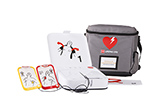Health and Safety is always top priority on any construction site; but do you have the kit you need for a medical emergency? And most importantly, do your contractors know where it is and can they reach it quickly and easily?
 The need for swift medical intervention has never been more clearly demonstrated than in the Euros incident that was broadcast to the world. The speed at which help was on hand and a defibrillator used was impressive, and thankfully a world class footballer was saved.
The need for swift medical intervention has never been more clearly demonstrated than in the Euros incident that was broadcast to the world. The speed at which help was on hand and a defibrillator used was impressive, and thankfully a world class footballer was saved.
But not everyone is as fortunate. Thousands of unnecessary and preventable deaths occur each year.

Some bleak facts… For every 1 minute that passes after a person has a sudden cardiac arrest, the chances of survival drop 10%. And, should a limb be seriously maimed or severed in an accident, it can take only 60 seconds before the worker loses enough blood to be rendered unconscious. Speed and response times in a medical emergency are critical.
Every second really does count!
So, having a ‘response ready’ kit is a great first step. But often, little thought then goes into where it should be placed. Trauma kits, defibrillators, tourniquets and even plasters that actually stick all need to be easily accessed and not in a locked office cupboard. Placement is key and a highly visible and central is always best.
If you’re on-site team does not know where to find it, precious time is lost. It could be placed on the wall in the site office; but is the office left unlocked even when unattended? Or it may be better, housed in a purpose built cabinet, that can be easily re-located as work progresses around the site. For large sites, consider how long it would take to get there and back if the defibrillator is located at the other end of the site. Is there still enough time to retrieve the equipment, unpack the kit and save the life? Or should you perhaps have more than one?
 Is your provision fit for purpose?
Is your provision fit for purpose?
Just as important is the need to check that the medical lifesaving equipment you have is fit for purpose – you would be surprised at how many are not! That does not just mean ‘in-date;’ but that workers who are not medically trained, can be assisted by equipment that is intuitive to use. Because, anyone can help save a life with equipment designed for public access use.
In the case of a tourniquet, a mega-fast and easy application, that is simple to tighten to the amount required to stop the blood flowing, is key. As is the need to choose the correct defibrillator; and there are many to choose from! Do you need a unit that is equally effective on all skin tones – not all are – and have you checked the resistance capacity to see if your defibrillator will shock effectively on larger chest sizes? Perhaps an intuitive unit that provides CPR guidance as well could be good too?
 Just having the medical equipment on site does not make you response ready or able to save a life when time is against you. But careful consideration of all relevant factors, and some small key changes, can help to swing the odds your way. At the end of the day, we are all committed to keeping our employees alive and safe. And, no-one wants the angst of having to shut a site for investigation, especially if it could so easily have been an unnecessary and preventable death.
Just having the medical equipment on site does not make you response ready or able to save a life when time is against you. But careful consideration of all relevant factors, and some small key changes, can help to swing the odds your way. At the end of the day, we are all committed to keeping our employees alive and safe. And, no-one wants the angst of having to shut a site for investigation, especially if it could so easily have been an unnecessary and preventable death.
So I ask again… How ready are you for a medical emergency?
For more information on Aero Healthcare’s defibrillators and first aid products, go to https://hubs.la/H0WtrwG0 email: sales@areohealthcare.co.uk or call: 01403 790704.
www.aerohealthcare.co.uk

